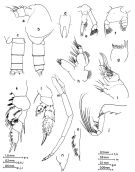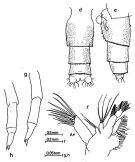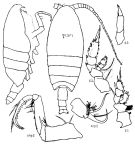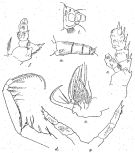|
|
 |
Fiche d'espèce de Copépode |
|
|
Calanoida ( Ordre ) |
|
|
|
Clausocalanoidea ( Superfamille ) |
|
|
|
Phaennidae ( Famille ) |
|
|
|
Cornucalanus ( Genre ) |
|
|
| |
Cornucalanus indicus Sewell, 1929 (F,M) | |
| | | | | | | Ref.: | | | Sewell, 1929 (p.179, Descr.F, figs.F); 1948 (p.540); Brodsky, 1950 (1967) (p.236, figs.F, Rem.); Vervoort, 1957 (p.93, Rem.); Tanaka, 1960 a (p.122, figs. juv.F); Tanaka & Omori, 1967 (p.250); Arashkevich, 1969 (p.702, figs.F); Silas, 1972 (p.647); Brodsky & Zvereva, 1976 (p.188, Descr.M, figs.M); Tanaka & Omori, 1992 (p.258, Rem.F,M, figs.M); Chihara & Murano, 1997 (p.853, Pl.139: F); Vives & Shmeleva, 2007 (p.685, figs.F,M, Rem.) |  issued from : O. Tanaka & M. Omori in Publ. Sero Mar. Biol. Lab., 1992, 35 (4/5). [p.259, Fig.3]. Male (from Izu region): a, forehead (lateral); b, last thoracic segments and urosome (lateral left side); c, urosome ((dorsal); d, rostrum (frontal view); e, A2; f, Md (mandibular palp); g, Md (cutting edge); h, Mx1; i, Mx2; j, Mxp; k, P1 (posterior); l, P2; m, P5; n, distal part of right P5; o, distal part of left P5. Nota: Rostrum consist of a plate with stout rami, each of which is followed by a small projection at apex. A1 extends to end of first urosomal segment. Mx1 reduced: 7 setae on outer lobe; 9 on exopod, 5 on basis, 3+6 on endopod, and 4 on 3rd and 2 on 2nd inner lobe; first inner lobe large but only armed with few small setae. Mx2 reduced: 4th and 5th lobes each armed with a large claw-like spiniform seta; endopod with 8 weak sensory filaments of which one is slender and longer than others. Prosome/Urosome lengths ratio 77 : 23. Cephalosome and 1st metasomal segment separated, 4th and 5th incompletely separated by a line of demarcation. Urosomal segments without spinules and caudal rami in the proportional lengths 16 : 33 : 26 : 15 : 4 : 6 = 100. P5, the right leg 3-segmented; distal segment armed with 2 spines; left leg 5-segmented and long; 1st to 4th segments about equal in length; 5th segment short, and with 1 distal and 1 lateral spine and patches of hairs.
|
 issued from : O. Tanaka & M. Omori in Publ. Sero Mar. Biol. Lab., 1992, 35 (4/5). [p.257, Fig.2]. Female (from Izu region): d, urosome and caudal rami (dorsal); e, idem (lateral left side); f, Mx1; g, h, P5. Nota: Prosome/urosome length ratio 74 : 26. Forehead round with no trace of cephalic spine. Urosome covered with spinules. Proportional lengths of segments and caudal rami 50 : 25 : 15 : 2 : 8 = 100. Lateral margin of genital complex inflated; genital tubercle prominent. Mx1: 9 setae on outer lobe, 10 on exiopod, 5 on basis, 10 on endopod, 4 on 3rd, 2 on 2nd and 10 on 1st inner lobe. P5 very small, 3-segmented; 2nd segment longer than the 3rd; there is a faint line of demarcation near the proximal 1/3 of 3rd segment; 3rd segment armed with a large inner terminal spine and small outer spine (although the inner terminal spine not developed well in another specimen).
|
 Issued from : K.A. Brodskii in Calanoida of the Far Eastern Seas and Polar Basin of the USSR. Opred. Fauna SSSR, 1950, 35 (Israel Program for Scientific Translations, Jerusalem, 1967) [p.237, Fig.148]. Female (from NW Pacif.): habitus (dorsal and lateral right side); Mp1, Mx2; Mp2, Mxp; S1, P1; S3, P3; S5, P5. Nota: P5 slightly asymmetrical in size and form. A specimen from the Pacific shows the following differences in comparison with those described from the Bay of Bengal: Head less rounded, spines of Mxp larger. The Pacific form possibly represents a separate variety.
|
 issued from : R.B.S. Sewell in Mem. Indian Mus., 1929, X. [p.180, Fig.66]. Female (from off SE Sri-Lanka): a, posterior thoracic margin and urosome (lateral left side); b, anal segment and furcal ramus (lateral): c, Mx2; d, Mxp; e, P2; f, P4; g, P5.
|
 issued from : O. Tanaka & M. Omori in Publ. Sero Mar. Biol. Lab., 1992, 35 (4/5). [p. 260]. Male: Proportional lengths of segments of A1.
| | | | | Ref. compl.: | | | Grice & Hulsemann, 1967 (p.16); Roe, 1972 (p.277, tabl.1, tabl.2); Vives, 1982 (p.292); Lozano Soldevilla & al., 1988 (p.58); Suarez-Morales & Gasca, 1998 a (p.110); Ikeda & al., 2006 (p.1791,Table 2); Galbraith, 2009 (pers. comm.); Homma & Yamaguchi, 2010 (p.965, Table 2); Homma & al., 2011 (p.29, Table 2, 3, abundance, feeding pattern: suspension feeders) | | | | NZ: | 6 | | |
|
Carte de distribution de Cornucalanus indicus par zones géographiques
|
| | | | | | | Loc: | | | Canary Is., off Morocco-Mauritania, G. of Mexico, Indian (off E Sri Lanka), Japan (Izu region, NE), Okhotsk Sea, Bering Sea, S Aleutian Basin, S Aleutian Is., off British Columbia (rare), | | | | N: | 7 | | | | Lg.: | | | (29) F: 8; (70) F: 9-8,2; (22) F: 9,24-8,8; (199) F: 7,37; (444) M: 7,65-7,3; (867) F: 8,9-9; M: 8,28; {F: 7,37-9,24; M: 7,30-8,28} | | | | Rem.: | méso-abyssopélagique.
Voir aussi les remarques en anglais | | | Dernière mise à jour : 02/01/2015 | |
|
|
 Toute utilisation de ce site pour une publication sera mentionnée avec la référence suivante : Toute utilisation de ce site pour une publication sera mentionnée avec la référence suivante :
Razouls C., Desreumaux N., Kouwenberg J. et de Bovée F., 2005-2025. - Biodiversité des Copépodes planctoniques marins (morphologie, répartition géographique et données biologiques). Sorbonne Université, CNRS. Disponible sur http://copepodes.obs-banyuls.fr [Accédé le 03 décembre 2025] © copyright 2005-2025 Sorbonne Université, CNRS
|
|
 |
 |







